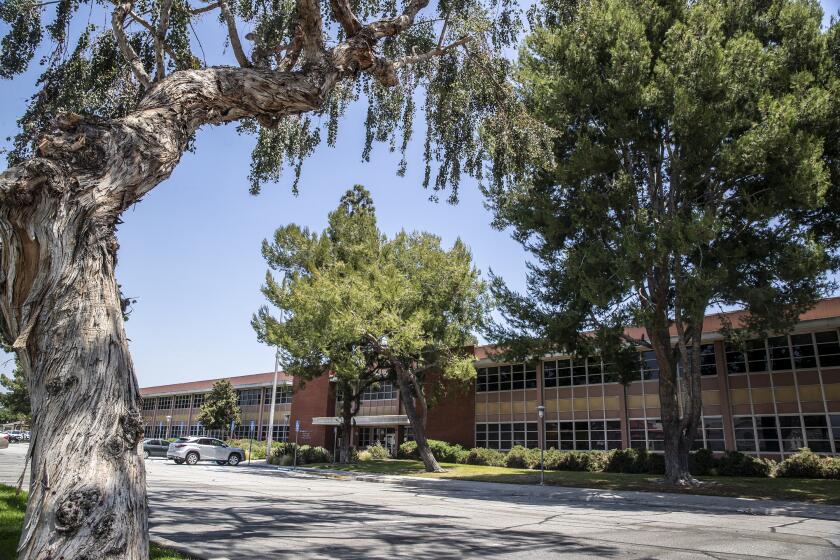On rural Wildcat Canyon Road, fears of uncaged development
- Share via
The morning talk on Wildcat Canyon Road has turned from rattlesnakes to tarantulas. Neighbors stand in the shade of the oaks and sycamores that arch over the cul-de-sac. It’s an impromptu gathering on a summer day when there is no great rush to be at work.
Summer, they say, is snake season, which overlaps tarantula season in the fall. Already, tarantula hawks — the orange-winged wasps that capture the spiders to feed their larva — are out hunting.
One resident, Steve Kerrigan, has lived on this road for 14 years; another, Chay Peterson, for 25 years. They marvel at their encounters with wildlife. It’s an easy point of consensus among friends who agree that they live in an unusual, if not precarious, corner of Southern California.
Wildcat Canyon Road is in the middle of Silverado Canyon, one of the last rural outposts in Orange County. To the east are the highest parts of the Santa Ana Mountains and the northernmost portion of the Cleveland National Forest, 165,000 acres of chaparral and coastal sage-scrub. To the west are the foothills, a swath of unincorporated and largely undeveloped land bordering Orange, Tustin and Irvine.
This year the Orange County Planning Commission and Board of Supervisors are expected to vote on two land-use applications that would affect Silverado: one, for a monastery and a school proposed for 124 acres at the base of Silverado Canyon, and the other, for a development of 65 homes on 114 acres a few miles down the road.
In addition, the 4th District Court of Appeal will decide, most likely next year, on the validity of a long-standing land-use plan that established guidelines for the open land inside and outside the canyon. The ruling, which will determine whether a local winery can expand its business, could open the area to more commercial development.
Each project offers a glimpse of a future that makes life in unincorporated Silverado seem all the more antiquated. Residents drive to the post office to get their mail. Each Wednesday, they listen to the fire siren being tested. Homes have neither gas nor sewage lines; propane and septic tanks are the norm.
It’s a life that the neighbors on Wildcat Canyon Road want to preserve, so talk of development, even if it is miles away, makes some of them nervous.
“We hear stories of property owners scraping land and planting rows of grapes. We fear that they want to turn this area into a Temecula Valley,” says Peterson, who 10 years ago helped organize a group of residents to fight for the open space outside Silverado Canyon.
Some of her neighbors wonder whether there can be compromise. “I don’t see the reason to fight everything,” says Kerrigan, who supports the monastery school and the winery’s expansion. “There’s room for some growth in the area.”
Over the years, the residents of Wildcat have come together over what nature throws at them — fires and floods — but what’s man-made is often more divisive.
::
Shaped like a backward L, Wildcat Canyon Road runs a quarter-mile before ending in dirt. It has 15 homes, one ranch and a posse of dogs that generally stops barking when told.
The neighborhood was evacuated during a 2007 wildfire and inundated with mud and debris during a 2010 storm, and its residents accept the terms of canyon life. The rules are simple: Don’t water the oaks. Trim native brush but leave the roots. Keep stream beds clear. Bring cats in at night.
The politics, however, are complicated; the motivations at times hard to discern. “What people really want — what people think is best — many times is what they think is best for themselves,” says Kerrigan’s neighbor Larry Gilstrap.
The question — how to manage development in the foothills — was raised after the Irvine Co. in 1962 rolled out plans for its holdings and after a Newport Beach company bought 5,000 acres a year later south of Silverado. Coto de Caza, as that property was called, has grown from 200 homes to 4,000 homes and two golf courses.
Concerned that similar projects could come closer to the canyons, residents of Silverado — and the nearby Modjeska and Trabuco canyons — drafted two land-use plans to protect nearly 40,000 acres lying between Irvine Lake and Rancho Santa Margarita. They believed that for ecological and recreational purposes, this land should serve as a buffer between the forest and the suburbs.
The Board of Supervisors approved the plans in 1977 and in 1991. Two years ago, however, the attorney for the county advised the board that one of the plans was not binding.
“Each plan has a clause that says they can be amended,” says Bill Campbell, supervisor for this district of Orange County. “To think that something gets written once and stays that way, well, nothing stays the same. The Ten Commandments, perhaps.”
Change is a sensitive subject on Wildcat Canyon Road among residents who believe that development in the foothills will affect the ecology of the canyons and the forest. It is a knowledge derived from a familiarity with canyon life that often begins in their frontyards.
::
No one is sure how Wildcat Canyon got its name. Some say it’s because of the mountain lions and bobcats. Others say it’s because of the winds that howl through its confines with the ferocity of wildcats. For Karta Khalsa, however, the canyon is best considered for its silence, sometimes no louder than the rustle of sycamore leaves.
“It’s inexplicable,” he says. “Being in the canyon is like being in space.”
Khalsa, 63, has lived here for seven years, and wandering onto a deck, he points to his favorite spot, an armchair overlooking the trees that crowd the creek. “I sit here and I feel like I’m in the middle of a portrait,” he says.
Peterson, 51, and her husband, Brett, live next to Khalsa. The couple moved to Wildcat in 1987 and raised two boys here. Their home is a remodeled cabin with rock siding, cedar shingles and salvaged window frames. A sycamore leans heavily against a dormer; Brett talks about taking the window down rather than cut the limb.
Such accommodations are common in the canyon, where nature is given a privileged place.
They once let a rattlesnake live in their side yard as a way to control the ground squirrel population. After the snake had its fill, they trapped it in a garbage can and let it loose in an unpopulated canyon.
Three doors down, at a home with a deck almost as big as the interior, Kerrigan, 50, maintains a journal of weather (March 18, 2012: 2.76 inches of rain) and an outdoor camera to capture the comings and goings in the creek (April 19, 2011: a mountain lion peering upstream).
At the end of the street, Alice Phillips has mastered the art of trapping and relocating tarantulas that have wandered into her house. She sleeps with windows closed, lest foxes rip through the screens at night.
Their street is the antithesis of nearby housing tracts with palm trees, tile roofs, paseos and perimeter walls. They know too that it’s not just the wildlife but the rural character of the canyon that needs protecting.
As development has crept closer to the foothills, local businesses — gas stations, a grocery store and a steakhouse — have closed, and like most suburbs, Silverado Canyon has grown dependent upon shopping centers and markets, in this case nearly 15 miles away.
Peterson believes there is room for development as laid out by the original land-use plans, which she says would help retain the identity of the canyon.
“Commercial development within Silverado was controlled by the specific plan to ensure that it served the canyon community,” she says, but that no longer seems to be the model. “Commercial development now needs to serve the county.”
Kerrigan is more laissez-faire. “People want to tell others how to use their property, but they don’t own the property,” he says. “Owners have a right to use the land as they want, so long as they follow the rules.”
::
A little before dusk, a tarantula makes its way across a path cut through the brush. Phillips, 61, lets it move out of the way before continuing her hike.
She first saw the ranch at the end of Wildcat Canyon Road when she was a teenager. Forty-two years later, she still lives here, leasing this ramshackle complex of buildings, clad in graying cedar shingles. She threads her way through sage, buckwheat and tall matilija poppies.
“It comes down to what kind of future we’re leaving the next generation,” she says. “Not everyone will want a concrete, well-lit environment. Some of us like to be close to nature and not be afraid of it, to be able to see the beauty of a strange bug or a tarantula and still be able to see the stars.”
After an hour, she returns home. The light from the window in her house illuminates the patio. Crickets chirp, louder than birds, and as the sky in the west darkens, starlight emerges above the ridgeline.
More to Read
Sign up for Essential California
The most important California stories and recommendations in your inbox every morning.
You may occasionally receive promotional content from the Los Angeles Times.











